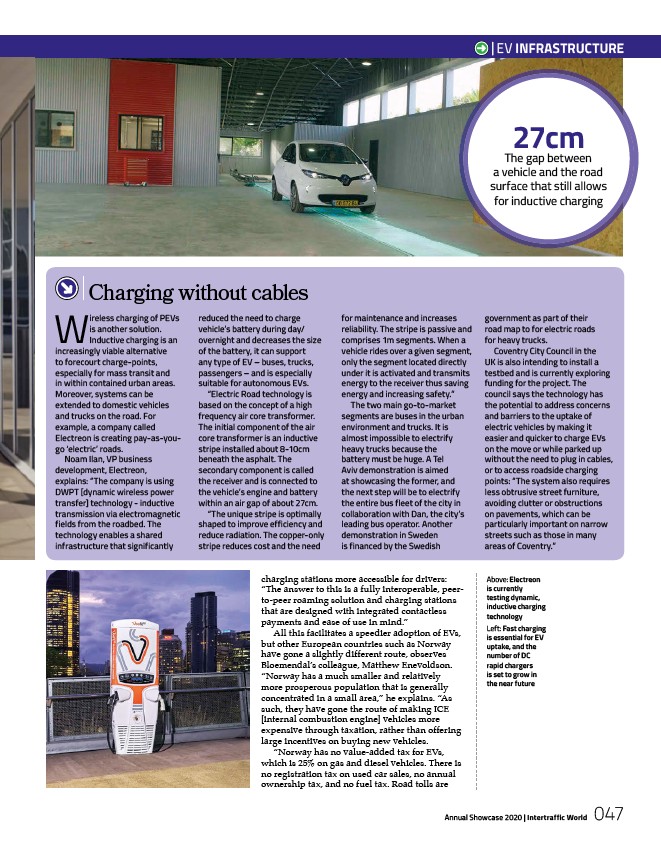
| EV INFRASTRUCTURE
27cm The gap between
a vehicle and the road
surface that still allows
for inductive charging
Annual Showcase 2020 | Intertraffic World
047
Above: Electreon
is currently
testing dynamic,
inductive charging
technology
Left: Fast charging
is essential for EV
uptake, and the
number of DC
rapid chargers
is set to grow in
the near future
Charging without cables
Wireless charging of PEVs
charging stations more accessible for drivers:
“The answer to this is a fully interoperable, peerto
peer roaming solution and charging stations
that are designed with integrated contactless
payments and ease of use in mind.”
All this facilitates a speedier adoption of EVs,
but other European countries such as Norway
have gone a slightly different route, observes
Bloemendal’s colleague, Matthew Enevoldson.
“Norway has a much smaller and relatively
more prosperous population that is generally
concentrated in a small area,” he explains. “As
such, they have gone the route of making ICE
internal combustion engine vehicles more
expensive through taxation, rather than offering
large incentives on buying new vehicles.
“Norway has no value-added tax for EVs,
which is 25% on gas and diesel vehicles. There is
no registration tax on used car sales, no annual
ownership tax, and no fuel tax. Road tolls are
is another solution.
Inductive charging is an
increasingly viable alternative
to forecourt charge-points,
especially for mass transit and
in within contained urban areas.
Moreover, systems can be
extended to domestic vehicles
and trucks on the road. For
example, a company called
Electreon is creating pay-as-yougo
‘electric’ roads.
Noam Ilan, VP business
development, Electreon,
explains: “The company is using
DWPT dynamic wireless power
transfer technology - inductive
transmission via electromagnetic
fields from the roadbed. The
technology enables a shared
infrastructure that significantly
reduced the need to charge
vehicle’s battery during day/
overnight and decreases the size
of the battery, it can support
any type of EV – buses, trucks,
passengers – and is especially
suitable for autonomous EVs.
“Electric Road technology is
based on the concept of a high
frequency air core transformer.
The initial component of the air
core transformer is an inductive
stripe installed about 8-10cm
beneath the asphalt. The
secondary component is called
the receiver and is connected to
the vehicle’s engine and battery
within an air gap of about 27cm.
“The unique stripe is optimally
shaped to improve efficiency and
reduce radiation. The copper-only
stripe reduces cost and the need
for maintenance and increases
reliability. The stripe is passive and
comprises 1m segments. When a
vehicle rides over a given segment,
only the segment located directly
under it is activated and transmits
energy to the receiver thus saving
energy and increasing safety.”
The two main go-to-market
segments are buses in the urban
environment and trucks. It is
almost impossible to electrify
heavy trucks because the
battery must be huge. A Tel
Aviv demonstration is aimed
at showcasing the former, and
the next step will be to electrify
the entire bus fleet of the city in
collaboration with Dan, the city’s
leading bus operator. Another
demonstration in Sweden
is financed by the Swedish
government as part of their
road map to for electric roads
for heavy trucks.
Coventry City Council in the
UK is also intending to install a
testbed and is currently exploring
funding for the project. The
council says the technology has
the potential to address concerns
and barriers to the uptake of
electric vehicles by making it
easier and quicker to charge EVs
on the move or while parked up
without the need to plug in cables,
or to access roadside charging
points: “The system also requires
less obtrusive street furniture,
avoiding clutter or obstructions
on pavements, which can be
particularly important on narrow
streets such as those in many
areas of Coventry.”